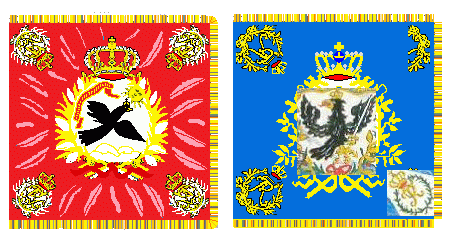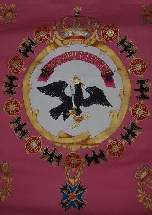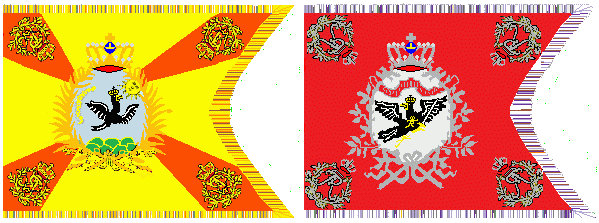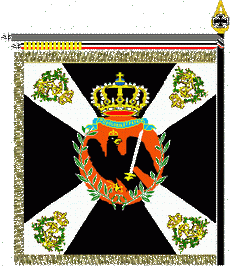|
Prussian Cavalry Regimental Standards in Times of Friedrich the Great
At the eve of the 1st Silesian War the Prussian Forces had 12 regiments of cuirassiers, 7 regiments of dragoons and just 2 regiments of hussars. Being conscious of the superiority of the excellent Austrian cavalry he laid stress upon a strong disciplined infantry. Nevertheless he raised some other 8 regiments of hussars, 5 regiments of dragoons and the regiment mounted life guards in the 1740ies being also conscious of the fact, that no battle could be one without a strong cavalry.

Examples of Cuirassiers´ Regimental Colours
Cuirassiers ("Kürassiere")
The cuirassiers had been the proper successors of the medieval knights. Cuirassiers were known since 1481. Their name was derived from the French word “cuir” (=leather). The cuirass was a kind of armour or corslet without sleeves having been made first of leather and later on of metal. Cuirassiers had been established since 1666 then called “mounted regiments” (German: Regimenter zu Ross) or heavy-armed cavalry.. Their erection had been finished in 1718. They were denoted as “cuirassiers” since 1741 in within daily orders. This denotation became common in 1742, was used as an unofficial name since 1758 and was officially used since 1786.
Being heavily armed and having the biggest horses cuirasseers were used on both wings within the 1st wave of an attack.
A regiment had five squadrons. The number of soldiers increased from 834 in 1740 up to 1000 soldiers in 1762. The 13th cuirassiers life guards (Garde du Corps) always was different. It had only one squadron in 1740 and increased up to three squadrons in 1756.

13th Cuirassiers Regiment It was the only regiment having a vexillum (a hanging flag) as its proper colour. All other cuirassiers had fringed square standards sized estimated between 30cm x 30cm and 40cm x 40cm (my estimation is based on a picture showing infantry and cavalry flags together to be seen at www.historischer-bilderdienst.de).

Examples of Dragooners´ Regimental ColoursDragoons
Dragoons were know since the 30-Years-War doing a task as mounted infantry or mounted musketeers. The had been introduced in the electorate of Brandenburg by DERFFLINGER in 1687 and had been successively built up. In 1744 the erection was complete. There name is derived from their weapon, a short rifle (or long pistol) having a dragon’s had as its handhold.
Dragoons were used within the 2nd wave of attack.
The regiments were divided into five squadrons, which were at the beginning subdivided into two companies. The 5th and 6th dragoons had ten squadrons.. The number of soldiers of a regiment was more or less the same like that one of the cuirassiers.
The standards of the dragoons were swallow-tailed and had a size estimated between 53cm x 30 cm and 67cm x 40 cm (source like above).
 Example of Hussars´ Regimental Colours (reverse side)Hussars (light cavalry)
Being considered as a "non-Prussian way of fighting" hussars regiments in the beginning were manned by mercenaries from other countries (for further details see my contribution about “Prussian Hussars Regiment “Queen Wilhelmina of the Netherlands” (Hanoverian) No.15 aka “Wandsbeker Husaren”). Friedrich the Great however recognized their importance very soon and raised numerous new hussars regiments. Hussars had smaller horses and a very special outfit.
They were used within the 3rd wave and their main task was to cause disturbances behind the enemy’s lines.
A regiment had ten squadrons having less riders than the squadrons of the other mounted regiments. The number of soldiers of a regiment increased from 1166 in 1740 up to 1681 in 1762.
The standards of hussars were pennants in hussar’s cut having a bordure in the colour of the saddle cloth. As the had been abolished in 1743, there are no images reported within source.
Source: [d2e92a], p.11-13
| See Prussian Cavalry Regimental Colours Chart for more examples |
Sources:
(1) [d2e92] by Günter DORN and Joachim ENGELMANN: "Die Infanterie Regimenter Friedrich des Großen 1756 - 1763", publ.1992
(2) [neu39a] by Otfried NEUBECKER: "Fahnen und Flaggen", Leipzig 1939
(3) [neu32] by Otfried NEUBECKER: "Historische Fahnen - die Welt in Bildern Album 8"
(4) [zna01] by Alfred ZNAMIEROWSKI: "Flaggen Enzyklpädie", Bielefeld 2001
(5) Images drawn by Klaus-Michael Schneider.
Return to: | Top of Page | "Prussian Flags Before 1800" | "Vexillological Essays and Chart Pages Menu" |
|